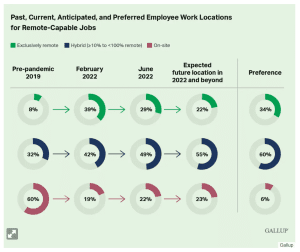
After the pandemic, heated debates about remote work dominated the U.S. media. Whether it was prominent public figures like Elon Musk demanding his workers to return to the office or tech companies like Google sorting out their remote work policies, everyone seemed to be debating the effectiveness of this new way of working.
This conversation didn’t just permeate in the U.S. In LATAM and Mexico’s IT industry, there was also a lot of discussion about remote work. Employers everywhere had to contend with this new force in the labor market: the demand for remote and hybrid work models. One region where remote work skyrocketed was Latin America. From Mexico to Brazil to Colombia, these countries saw their numbers of remote work rise and cause major changes to some of the country’s industries.
In Latin America, remote work rose to prominence almost overnight. This switch to remote work seemed even more dramatic than it did in the U.S. because, prior to covid, Latin America did not have as many companies already operating remotely.
Remote Work and Remote-Capable Employees in the U.S.
Like in the U.S., certain industries embraced the remote work model wholeheartedly— some more than others. In the U.S., the Computer and IT industry led all other industries in remote work. Other industries that score high in the remote work category include the marketing industry, accounting, and finance. In addition to that, other industries that showed some increase in remote work included non-profits, communications, and legal.
According to Gallup, about 56% of full-time employees in the U.S. claim it is possible to perform their job 100% remotely. Gallup deems this sector of the workforce as ‘remote-capable’ employees. Patterns in the U.S. seem to show that remote work skyrocketed during and immediately after the pandemic then slowly falling in late 2022 and projected to fall even more in subsequent years.

Whether this projected pattern pans out remains to be seen, but it appears returning to the office is more popular in the U.S. than it is elsewhere. There are more companies in the U.S. pushing for a return to the office than in other countries. What does the picture look like to the South and across Latin America? We explore the question below.
Remote Work in Latin America
A major change happened in LATAM in the last five or so years. The region has a massive population and has seen a smartphone adoption rate increase of 40% over the last five years. The LATAM region overwhelmingly prefers or uses Android devices. These changes create a bigger demand for digital tools and therefore digital transformation, which requires top-quality developers and engineers.
Digital adoption has changed the LATAM landscape and everyday life. According to ATLANTICO’S digital report, Brazil and Mexico have higher numbers of people using the internet than the U.S., which is a key indicator investors and entrepreneurs look at to gauge the region’s potential for digital growth in the coming years. According to Latitud, as the LATAM region reaches China’s internet penetration companies in the region are positioned to reach up to 3.2 trillion dollars in economic value.
Throughout LATAM remote work before and after COVID-19 looks very similar to that of the United States. In other words, prior to the pandemic the majority of workers (62%) were working remotely less than 25% of the time. After the pandemic, that group shrank to 19%. People working 100% remotely was at 14% prior to the pandemic; afterward, that number kicked up to 36%.

And, like in the U.S., certain industries were more likely to embrace the move to remote work. In Latin America, the top remote-working industries were consulting, technology, education, marketing, and entertainment. These industries seem to be similar to those that embraced remote work across other areas.
Remote Work in Mexico
In recent years, a wave of remote work has also hit Mexico, both for the locals and for traveling digital nomads that have found Mexico a welcoming place for those working out of a laptop. In fact, in 2021, Mexico was deemed one of the fastest-growing places for remote workers, attracting thousands of young tech professionals to travel the country. This population has contributed to improving digital infrastructure in the country, forming co-work spaces, and embracing remote work culture.
Our Mexico Tech Salaries Report 2023 revealed interesting statistics about Mexico’s tech professionals and how they view remote work.
Among working tech professionals in Mexico, 42.1% prefer remote work and 26.6% prefer hybrid models. That’s a total of 68.7% of working professionals preferring at least some form of remote work option. At the same time, 24.7% preferred flexible working options, and only 6.6% of respondents wanted on-site work.

Our survey also revealed that out of tech professionals currently working on on-site jobs, about 16.28% preferred it that way. About 41.43% preferred a hybrid model, 22.83% opted for a flexible model, and 19.47% would vote for remote.

For tech professionals that continue going to the office, having some flexibility seems to be an important consideration. This indicates that even among professionals currently in an on-site position, a significant majority of them would prefer some kind of remote option.
Hire Remote Tech Talent in Mexico
As a talent solutions partner, we’ve helped many U.S. companies hire world-class talent in Mexico. Today, Mexico is largely remote-first and thus companies looking to build dedicated remote teams can look at one of several tech hubs in Mexico—like Guadalajara, Monterrey, Mexico City, and across the country—to find elite software developers, engineers, project managers, and other in-demand tech roles.
Want to learn more about the unique aspects of Mexico’s tech talent pool and talent market? Talk to one of our experts working with Mexico’s elite talent and learn how your company can find the right team member.


